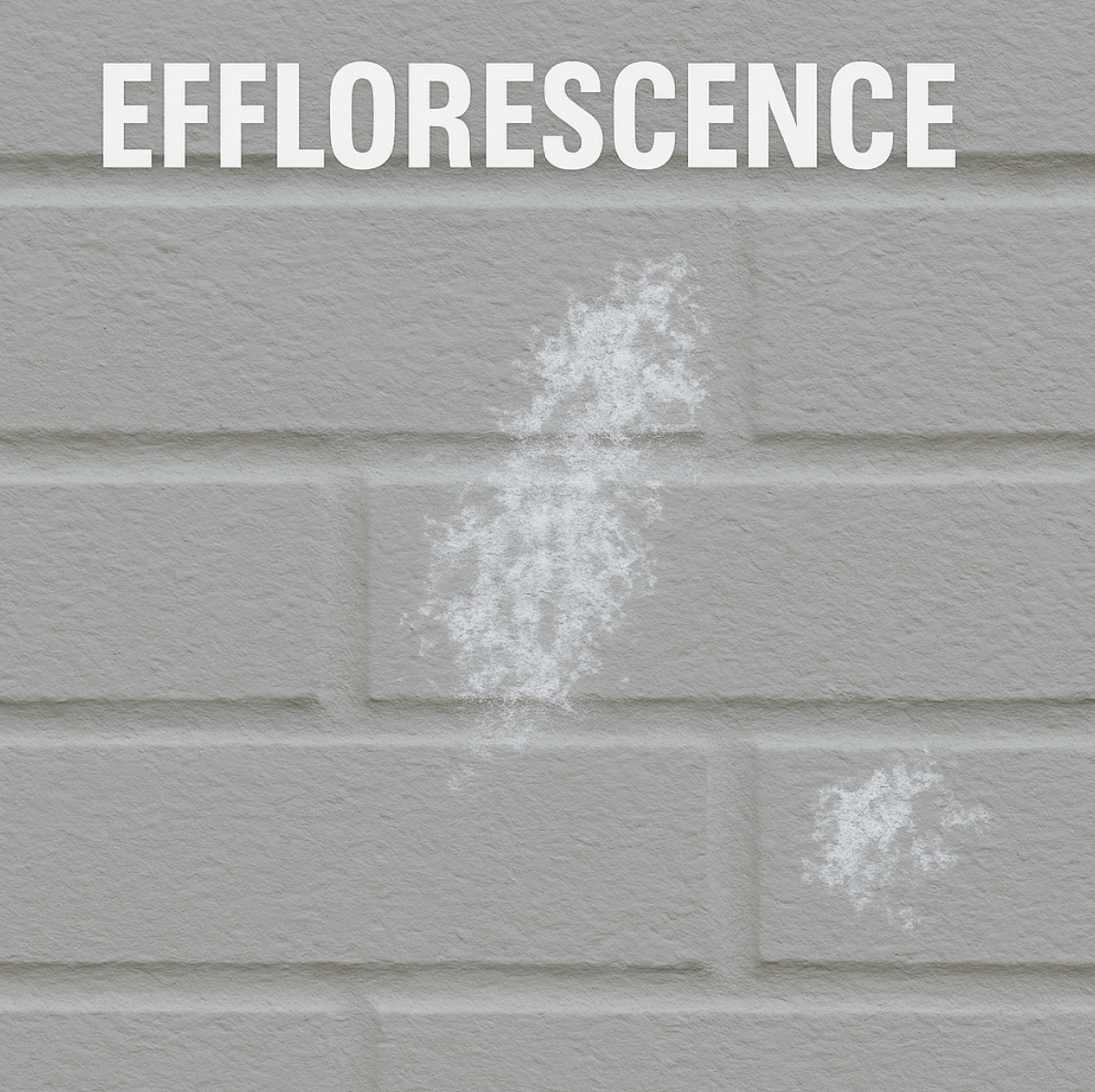Efflorescence is the appearance of white, powdery, or crystalline deposits on the surface of a painted wall, usually masonry, brick, or concrete. It occurs when water-soluble salts present in the substrate are dissolved by moisture, carried to the surface, and deposited as the water evaporates.
How it looks
- White, chalky streaks, patches, or fluffy crystals on the paint surface.
- Often patchy or streaked, especially on exterior walls.
- May reappear after cleaning if the underlying moisture problem isn’t solved.
Causes
- Moisture movement through masonry or render (rain, leaks, rising damp).
- Painting before masonry is fully dry, trapping moisture and salts.
- Porous or unsealed substrates that allow water to penetrate.
- Poor drainage or waterproofing, leading to constant dampness.
Here’s a step-by-step guide to fix efflorescence (salt deposits) on painted masonry.
Tools & materials
Stiff nylon brush • Vacuum • Bucket & sponge • Sugar soap/mild detergent • White vinegar or commercial efflorescence remover • (Optional) Hydrochloric acid (HCl) for stubborn cases • Bicarbonate of soda (neutraliser) • Painter’s tape & drop sheets • Alkali-resistant masonry primer/sealer • Quality breathable (acrylic) topcoat • Caulk/sealant • PPE: gloves, goggles, mask/respirator
Step 1 – Find and stop the moisture
- Check/repair leaks, gutters, flashings, cracked mortar, failed caulking, blocked weep holes, garden beds against walls, rising damp.
- Improve drainage & ventilation. Do not repaint until the moisture source is fixed.
Step 2 – Dry the wall
- Let the area dry completely (sunny, ventilated days). If you have a moisture meter, aim for ≤12–15% in the substrate.
Step 3 – Dry removal first
- Brush off the white powder with a stiff nylon brush; vacuum the dust. Avoid flooding with water at this stage.
Step 4 – Dissolve remaining salts
- Wash with clean water and a sponge; allow to dry and check if salts reappear.
- If stains persist:
- Mild option: 1:1 white vinegar : water. Scrub, rinse thoroughly.
- Stubborn option (exterior masonry only): 1 part HCl to 10 parts water (add acid to water, never the reverse). Short contact (2–5 min), scrub lightly, then rinse generously.
- Neutralise after acid: wipe with bicarbonate solution (1 Tbsp per litre water), then rinse again. Protect metals, glass, limestone, and plants.
Step 5 – Wait & verify
- Let the wall dry 24–72 hrs. If white salts return, repeat Step 4 until the surface stays clean after a dry period.
Step 6 – Surface prep
- Wash with sugar soap/detergent, rinse, and dry. Scrape any loose paint; feather-sand edges smooth; dust off.
Step 7 – Prime correctly
- Spot or full-prime with an alkali-resistant masonry sealer/primer (penetrating type for porous/rendered areas). Use a vapour-permeable system so moisture can escape.
Step 8 – Repaint
- Apply two thin coats of a breathable exterior acrylic (or interior masonry paint). Observe recoat times. Keep out of direct hot sun and strong wind.
Step 9 – Seal entry points
- Re-caulk joints, penetrations and window/door perimeters. Maintain caps, copings, and clear weep holes.
Don’ts
- Don’t just paint over efflorescence—salts will force new paint off.
- Don’t acid-wash plasterboard, limestone, or metals.
- Never mix acid with bleach or other cleaners.
Call a pro when…
- You suspect rising damp (needs a damp-proof course/injection).
- Efflorescence keeps returning despite repairs, or large areas of paint have failed.







